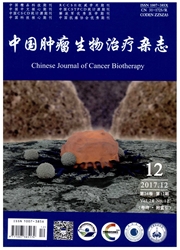

 中文摘要:
中文摘要:
目的:观察血管内皮细胞生长因子(vascular endothelial cell growth factor,VEGF)信号对溃疡性结肠炎(ulcerative colitis,UC)癌变的影响并探讨其作用机制。方法:建立小鼠肠炎相关结直肠癌(colitis-associated colorectal cancer,CAC)模型,用流式细胞术和real.timePCR分别检测模型小鼠外周血、脾脏、骨髓及瘤组织中髓样来源的抑制性细胞(myeloid—derived sup—pressor cell,MDSC)的比例和MDSC中精氨酸酶1(arginase一1,Arg—I)和诱导型-氧化氮合酶(inducible nitric oxide synthase,iNOS)mRNA的表达,ELISA法检测结肠和CAC组织培养上清中VEGF的表达。以索拉菲尼(sorafenib)或VEGF单抗阻断VEGF信号后,检测小鼠结肠和CAC部位MDSC比例的变化和病理改变。结果:成功建立小鼠CAC的模型,并根据多项评价指标确定建模后1个月和3个月为CAC的早期和晚期。在CAC形成过程中,小鼠体内Gr-1+CDllb+MDSC细胞数量明显增多,病灶部位MDSC的积聚尤甚,对照组为(0.30±0.18)%、CAC早期组为(1.32±0.04)%、CAC晚期组为(3.08±0.29)%(P〈0.05)。这些MDSC细胞高表达Arg—I和iNOS(P〈0.05),但病灶部位三一精氨酸含量显著降低[早期组为(4.22±0.17)μg/llll、晚期组为(2.95±1.08)μg/ml、对照组为(4.41±0.16)μg/ml,P〈0.05]。此外,与对照组相比,CAC早期和晚期病灶组织高表达VEGF[CAC早期组为(1170±94.43)ps/ml、晚期组为(1117±71.92)pg/ml、对照组为(877.6±31.67)pg/ml,P〈0.05]。索拉菲尼或VEGF抗体的治疗可显著抑制病灶部位MDSC的积聚。结论:VEGF信号在CAC形成过程中发挥重要的促瘤功能,其作用机制可能与诱导MDSC在病灶部位的聚集有关。
 英文摘要:
英文摘要:
Objective: To investigate the role and mechanism of vascular endothelial growth factor (VEGF) signaling in the development of ulcerative colitis (UC) -related cancer. Methods : Colitis-associated colorectal cancer (CAC) model was established in Balb/c mice. The proportion of myeloid-derived suppressor cells (MDSCs) in the peripheral blood, spleen, bone marrow and tumor tissues of the model mice and lesions was examined by flow cytometry. Arginase-1 (Arg-1) mRNA and inducible nitric oxide synthase (iNOS) mRNA expressions in MDSCs were detected by qPCR. The VEGF expression in the supematants of colonic tissues was determined by ELISA. Sorafenib or neutralizing anti-VEGF antibodywas used to block VEGF signaling and the proportion of MDSC in colonic lesions and the histopathology of CAC were de- tected. Results : Murine CAC model was established successfully. 1 month and 3 months after the beginning of CAC were verified as the early and late stages of CAC respectively, according to several parameters. The increased number of Gr-1 +CD11 b + MDSC was observed in the progression of CAC and was more significant in lesions: control (0.30 ± 0. 18 )% , early stage of CAC ( 1.32 ± 0.04) %, late stage of CAC (3.08 ± 0.29) % ( P 〈 0.05 ). These MDSCs expressed a high level of Arg-I and iNOS (P 〈 0.05 ). But the levels of L-arginine in colonic lesions of CAC mice was much lower than controls (early stage of CAC [4.22 ±0.17] μg/ml, late stage of CAC [2.95 ±1.08] p,g/ml, control [4.41±0.16] p,g,/ml, P 〈 0.05). Furthermore, VEGF expression in the lesions of CAC mice was elevated significantly ( early stage of CAC [ 1170 ± 94.43 ] pg/ml, late stage of [ 1117 ± 71.92 ] pg/ml, control [ 877.6 ± 31.67 ] pg/ml, P 〈 0.05). The treatment of sorafenib or anti-VEGF dramatically reduced accumulation of MDSC in the lesions. Conclusion: VEGF plays a pro-tumor role in CAC formation, which may be related with the induced accumulation of MDSC in colonic tissues.
 同期刊论文项目
同期刊论文项目
 同项目期刊论文
同项目期刊论文
 Blockade of complement activation product C5a activity using specific antibody attenuates intestinal
Blockade of complement activation product C5a activity using specific antibody attenuates intestinal Disease-promoting role of tumor necrosis factor receptors in 2,4,6-trinitrobenzene sulfonic acid (TN
Disease-promoting role of tumor necrosis factor receptors in 2,4,6-trinitrobenzene sulfonic acid (TN Interleukin-17- producing gammadelta(+) T cells protect NOD mice from type 1 diabetes through a mech
Interleukin-17- producing gammadelta(+) T cells protect NOD mice from type 1 diabetes through a mech Regulation of IL-8 production by complement-activated product, C5a, in vitro and in vivo during seps
Regulation of IL-8 production by complement-activated product, C5a, in vitro and in vivo during seps Glutamic acid decarboxylase-derived epitopes with specific domains expand CD4+CD25+ regulatory T cel
Glutamic acid decarboxylase-derived epitopes with specific domains expand CD4+CD25+ regulatory T cel 期刊信息
期刊信息
